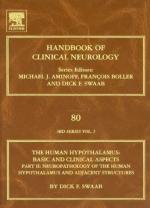|
This section contains 439 words (approx. 2 pages at 300 words per page) |

|
The hypothalamus, a part of the diencephalon, lies at the base of the cerebrum, beneath the thalamus. The hypothalamus forms the base of the lateral wall or boundary of the third ventricle and extends from the optic chiasma to the caudal border of the mammillary bodies (both of which are considered a part of the hypothalamus). Anatomically, the hypothalamus includes the pituitary gland but physiologically they are treated as separate entities. The hypothalamus also includes the tuber cinereum and infundibulum.
The hypothalamus is the coordinating complex or control center for the autonomic nervous system (ANS) (e.g., ANS reflex arc connections are made in the hypothalamus) and the neuroendocrine system. Accordingly, the hypothalamus plays a regulatory role in the coordination of involuntary actions and processes (e.g., changes in blood pressure, urinary output, gastrointestinal motility, etc).
Both ascending visceral and somatic pathways provide afferent nerve pathways to the...
|
This section contains 439 words (approx. 2 pages at 300 words per page) |

|


